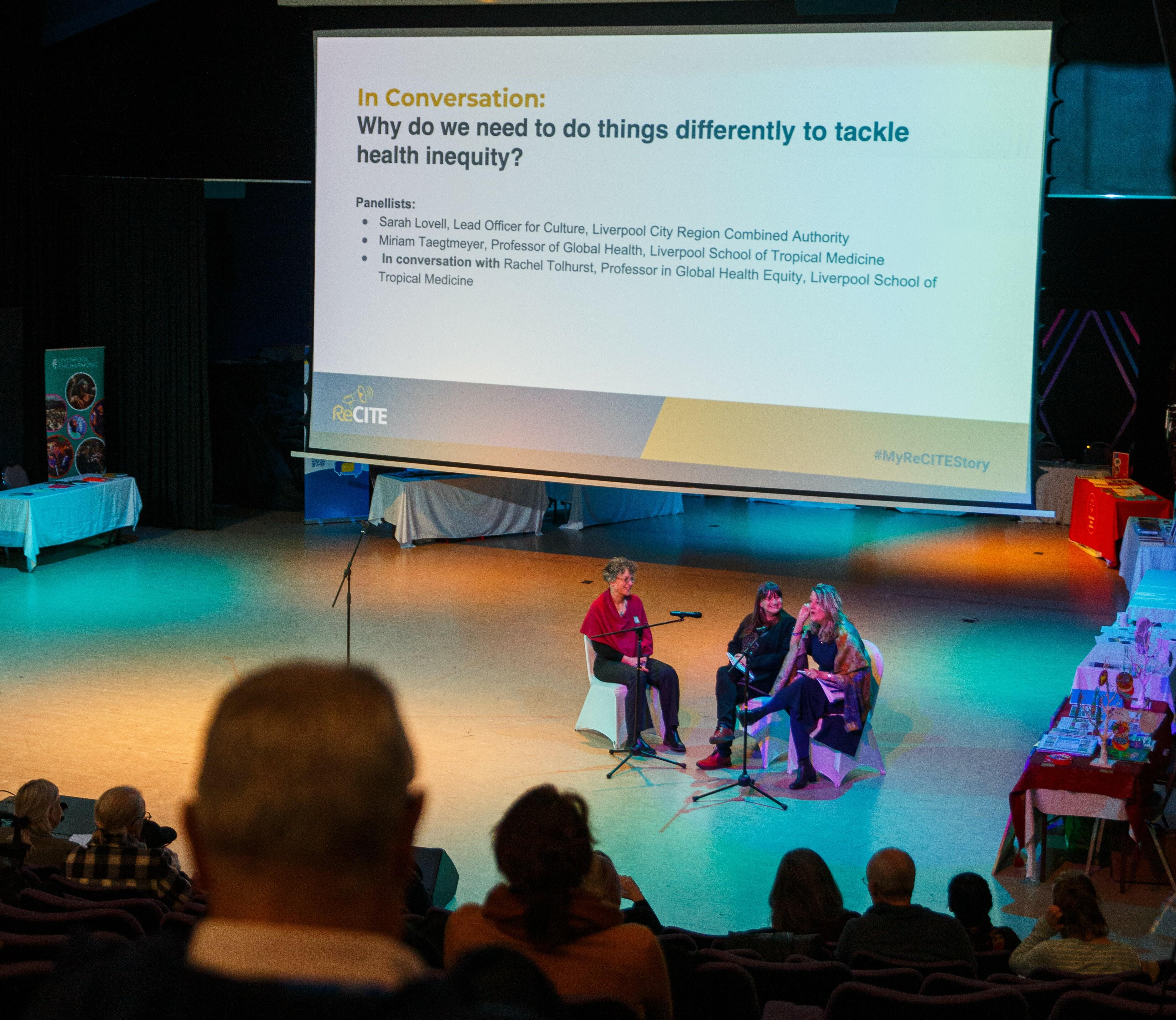
The stories shared at the recently held What’s Your Story celebration event painted a stark picture of how people experience the NHS in Liverpool, moments where the system let people down. Missed opportunities, systemic inequities, poor listening and lack of feeling respect and dignity. Listening to these accounts, LSTM’s Professor Miriam Taegtmeyer - an NHS clinician and principal investigator of ReCITE - found herself wondering:
Do we ever get it right? Are we only hearing what went wrong?
These questions lingered, offering opportunity for deeper reflection. Conversations about health equity so often highlight failures - where systems collapse, where individuals slip through the cracks, where care is compromised. But how can these individual truths create meaningful change in an under resourced system with so little wiggle room?
The Emotional Toll
Like many of us, clinicians go to work because they want to do a good job. They are motivated by caring for people, easing symptoms, providing diagnosis and treatment. For clinicians and healthcare workers, stories of failure can be demoralising and upsetting, especially when staff are already overstretched and trying hard in difficult circumstances. It can feel like an indictment, as though the burden of systemic flaws rests solely on their shoulders. But failure is rarely about a single individual. It is about structures, policies, and historical inequities that shape the landscape of care. The question we need to ask is:
How can we engage with difficult stories and create space for learning, progress, and shared responsibility?
Reframing the Conversation
If we only talk about what went wrong, do we miss out on valuable lessons from what went right? The reality is that healthcare is filled with moments of compassionate, effective, and life-changing care. Stories of resilience and of people going above and beyond to make up for a broken system. Stories that are just as instructive as failures. What if we gave them equal weight? What if we balanced critique with celebration? Learning from failure with learning from best practice? Otherness with togetherness?
Opportunities to Build Bridges:
1. Systems-Level Change
Blame isolates, but structural reform unites. Instead of focusing on individual health care worker shortcomings, we should address the policies, funding mechanisms, and structural inequities that perpetuate failures. This means patients and health care workers joining together in advocacy for:
- Better resource allocation for underfunded areas.
- Training programs that prioritize cultural competency and inclusivity.
- Addressing the broader social determinants of health that impact outcomes.
2. Supporting Health Workers
Health equity efforts cannot succeed if clinicians themselves are struggling. Burnout, mental health strain, and excessive workloads limit the capacity for meaningful engagement and exacerbate avoidable and unfair differences in health. Providing:
- Psychological support for frontline workers, allowing them to be listened to and their story to count.
- Equitable workloads and fair working conditions.
- Spaces where clinicians can express concerns without fear of retribution.
3. Empowering Clinicians as Change Agents
Many health professionals are deeply committed to tackling health equity but lack institutional support. Instead of leaving them to navigate these issues alone, we must:
- Create platforms where they can advocate for change.
- Provide leadership opportunities to influence policy and practice.
- Foster trusting, safe environments where speaking out leads to progress, not punishment.
4. Data and Storytelling for Solutions
If we only collect data on failures, we build a narrative of dysfunction. But data can also illuminate what works. How can we use storytelling to showcase:
- Instances where systemic interventions led to improved patient outcomes?
- Examples of compassionate care that made a difference?
- Policies that successfully reduced disparities and improved access?
5. Strengthening Community Collaboration
Health equity is not just a healthcare issue - it is a societal one. Building meaningful partnerships with patients, healthcare workers, advocacy groups, and policymakers shifts the conversation from individual blame to collective action. This means:
- Co-creating solutions with communities affected by inequities.
- Encouraging dialogue between patients and providers to foster understanding.
- Recognising that lasting change happens when institutions and communities work together.
6. Creating Space for Clinician–Patient Dialogue
To truly shift the culture of healthcare, we must move beyond speaking about patients or about health care workers and start speaking with them. One emerging idea is to create opportunities for patients and clinicians to meet as equals - not in the clinical setting, but in a neutral, co-owned space designed for open, structured conversation and building trust.
Such fora could become a vital tool for healing systemic mistrust, sharing experiences, and co-designing solutions that reflect both lived realities and clinical insight.
What could this look like in practice?
- Story Circles and Listening Sessions: Safe, facilitated spaces where patients share their experiences both painful and positive, and clinicians reflect without defensiveness and vice versa.
- Co-Learning Opportunities: Joint workshops or panels where both patients and professionals learn about cultural safety, communication, and the systemic forces shaping care.
- Feedback Without Retaliation: A non-hierarchical, safe environment where patients can offer honest feedback, and clinicians can speak candidly about constraints they face.
- Pilot Projects and Co-Design: Small-scale initiatives that test new care approaches, designed and evaluated with health equity gaps in mind.
- Peer Networking: An opportunity for clinicians to connect with others committed to health equity and for patients to move from being case studies to change agents.
What is common to all of these is that they are not reacting to problems but imagining solutions together - clinicians and patients side-by-side. Such spaces would not only support accountability and compassion but help rebuild trust in a system that many feel has forgotten them.
Towards a More Balanced Narrative
Storytelling is a powerful advocacy tool but to be effective its purpose must not be to shame; but to illuminate. It is about learning, accountability, and progress. Telling stories where the health system has failed individuals does not diminish the dedication of healthcare workers; rather, they highlight the urgent need for systemic change.
It’s not about whether doctors ‘ever get it right’, but about how the system fails people who don’t fit into neat, expected categories or whose care needs are unplanned. That’s where change is needed.
Then the real question is not just whether we get it right but how we ensure that when we do, it is not by chance, but by design.
|
ReCITE is funded by the Arts and Humanities Research Council (AHRC), part of UK Research and Innovation. |
 |

Join our LinkedIn community.